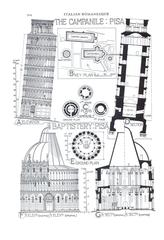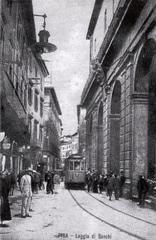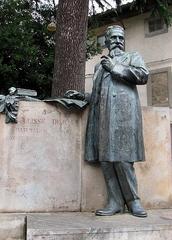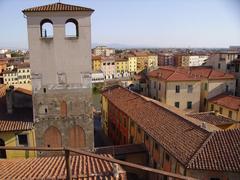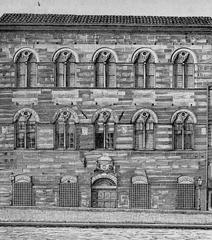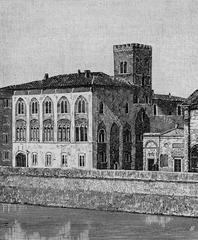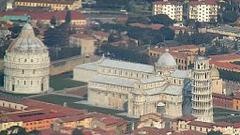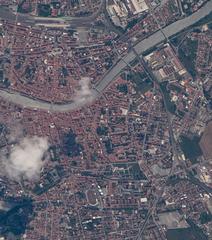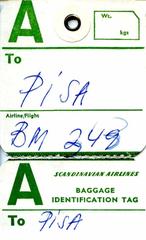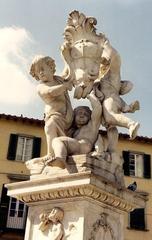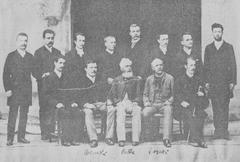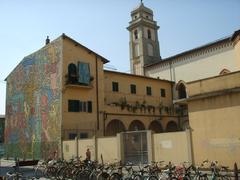Visiting Rocca della Verruca: Hours, Tickets, and History in Pisa, Italy
Date: 25/07/2024
Introduction
Nestled atop Monte Verruca in Pisa, Italy, Rocca della Verruca is a historical fortress with an elevation of 537 meters above sea level. This ancient stronghold offers visitors a glimpse into the rich tapestry of Pisa’s strategic and cultural history. Known as “the eye of the Pisans,” the fortress’s strategic position allowed it to dominate the Pisan plain and oversee the course of the Arno River (terredipisa.it). It served as a crucial defensive structure during the medieval period, with its origins tracing back to before the year 1000. The fortress’s construction utilized Verruca stone, indicative of the region’s geological resources (montepisano.travel). Over the centuries, Rocca della Verruca has witnessed numerous conflicts, particularly between Pisa and Florence, and even drew the attention of the legendary Leonardo da Vinci. This guide aims to provide a comprehensive overview of Rocca della Verruca, covering its historical significance, architectural marvels, visitor information, and travel tips for those eager to explore this fascinating site.
Table of Contents
Historical Background
Strategic Importance and Early History
Rocca della Verruca, perched at 537 meters above sea level, has been a significant stronghold in the defensive system of the Pisa Republic. Its strategic location allowed it to dominate the Pisan plain and oversee the course of the Arno River, earning it the moniker “the eye of the Pisans” (terredipisa.it). This vantage point enabled the fortress to signal impending threats to Pisa through a series of visual signals, such as waving flags, lighting fires, and ringing bells, which were then relayed to the city.
The earliest records of Rocca della Verruca date back to before the year 1000, with its name derived from the mountain it sits upon, which resembles a wart (terredipisa.it). The fortress’s most ancient part, constructed in the 8th century, was built using Verruca stone, a testament to the region’s geological resources (montepisano.travel).
Architectural Features
The fortress’s architecture is notable for its pentagonal plan, which, despite its current dilapidated state, retains a certain charm (terredipisa.it). The main structure included barracks, parade grounds, stores, a cistern, and a church, making it a self-sufficient military installation. One of the most intriguing features is a secret passage located at the north-west bastion, purportedly leading outside the fortress for escape purposes. Although the legend of a 10 km tunnel reaching Pisa remains unverified, it adds to the fortress’s mystique (terredipisa.it).
The Florentine Conquest and Destruction
The fortress played a crucial role in the conflicts between Pisa and Florence. In 1402, following the Florentine conquest of Pisa, the stronghold was deliberately destroyed to prevent it from becoming a threat again (montepisano.travel). This act of destruction underscores the fortress’s strategic importance and the lengths to which the Florentines went to secure their dominance over Pisa.
The First Trace of the Italian Language
One of the most significant historical artifacts associated with Rocca della Verruca is an epigraph that is considered the first document in “vulgar” Italian. This epigraph, dated “a dì dodici di giugno MCIII” (the 12th of June 1503), is preserved in the Museo Nazionale di San Matteo in Pisa (terredipisa.it). This artifact provides invaluable insight into the linguistic evolution of the Italian language and highlights the fortress’s cultural significance.
Leonardo da Vinci’s Connection
Rocca della Verruca is also linked to the legendary Leonardo da Vinci. In 1504, Da Vinci visited the fortress with the ambitious plan to redesign the course of the Arno River and flood Pisa, an endeavor that ultimately failed (terredipisa.it). Additionally, it is said that Da Vinci drew inspiration from the fortress’s steep height for his designs of flying machines, further cementing the site’s place in the annals of history and innovation.
Archaeological and Historical Studies
Even today, Rocca della Verruca remains a subject of archaeological study and excavation. These ongoing efforts aim to uncover more about the fortress’s past and its role in the region’s history (freedome.it). The site continues to offer a wealth of historical and cultural insights, making it a valuable resource for historians and archaeologists alike.
Legends and Myths
The fortress is shrouded in legends and myths that add to its allure. One such legend involves a secret passage that supposedly extends over 10 km to Pisa, a tale that, while highly improbable, captures the imagination of visitors and historians alike (terredipisa.it). These stories, whether based in fact or fiction, contribute to the fortress’s enigmatic reputation and its enduring appeal.
Modern-Day Significance
Today, Rocca della Verruca stands as a monument to the region’s rich history and cultural heritage. Despite its ruined state, the fortress continues to attract visitors who are drawn to its historical significance and the breathtaking views it offers of the surrounding landscape (montepisano.travel). The site serves as a poignant reminder of the past conflicts and the strategic importance of the region in medieval times.
Visitor Experience
Visiting Hours and Tickets
Rocca della Verruca is open to visitors year-round, with visiting hours typically from 9 AM to 7 PM. However, it is advised to check the official website or local tourism information for the most up-to-date visiting hours. Admission to the fortress is generally free, but certain guided tours or special events may have associated costs.
Travel Tips and Accessibility
To reach Rocca della Verruca, visitors can embark on a challenging hike or opt for a more leisurely e-bike tour. The terrain can be rugged, so appropriate footwear and sufficient water are recommended. The site is not fully accessible to those with mobility issues due to its uneven and steep paths.
Nearby Attractions
While visiting Rocca della Verruca, consider exploring other historical sites in Pisa, such as the Leaning Tower of Pisa, Piazza dei Miracoli, and Museo Nazionale di San Matteo. These nearby attractions offer a deeper dive into the region’s rich history and architectural splendor.
Special Events and Guided Tours
Rocca della Verruca occasionally hosts special events and guided tours that provide unique insights into its history and significance. These events are often advertised on local tourism websites and can offer a more immersive experience.
FAQ
What are the visiting hours for Rocca della Verruca?
The fortress is generally open from 9 AM to 7 PM, but it’s best to check the official website for the most current information.
Are there any admission fees?
Admission is usually free, though some guided tours and special events may require a fee.
How can I reach Rocca della Verruca?
Visitors can hike or take an e-bike tour to reach the fortress. Ensure you’re prepared for rugged terrain.
Is Rocca della Verruca accessible for those with mobility issues?
Due to its uneven and steep paths, the site is not fully accessible to individuals with mobility issues.
Conclusion
Rocca della Verruca’s historical background is rich with strategic importance, architectural ingenuity, and cultural significance. From its early construction to its role in the Pisa-Florence conflicts, and its connection to Leonardo da Vinci, the fortress offers a fascinating glimpse into the past. Today, it continues to captivate visitors and scholars alike, standing as a testament to the enduring legacy of the Pisa Republic. For those planning a visit, don’t forget to check the visiting hours, prepare for the hike, and explore the nearby historical sites in Pisa. Rocca della Verruca not only offers a window into the past but also serves as a poignant reminder of the region’s enduring legacy. For more information and travel tips, follow our updates on social media or download our mobile app for a more immersive experience.
References
- Terre di Pisa. (n.d.). The Verruca Fortress. Retrieved from terredipisa.it
- Monte Pisano. (n.d.). Rocca della Verruca. Retrieved from montepisano.travel
- Vicopisano Turismo. (n.d.). La Verruca Storia. Retrieved from vicopisanoturismo.it
- Freedome. (n.d.). Trekking Rocca della Verruca. Retrieved from freedome.it
- Visit Tuscany. (n.d.). Verruca Fortress. Retrieved from Visit Tuscany

